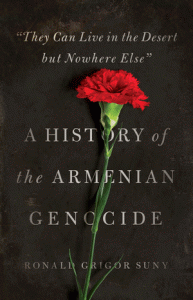OXFORD, OH- On March 18, University of Michigan Professor Ronald Suny spoke to students and faculty at Miami University about his recently published book, “They Can Live in the Desert but Nowhere Else”: A History of the Armenian Genocide, and why and how the Armenian Genocide was carried out.
Suny began his lecture with the statement that today, 100 years after as many as 1 million Armenians were killed in the Ottoman Empire, there is still disagreement about whether the tragedy should be classified as a genocide. A few select groups (including the Turkish government) adhere to a “denialist” stance, saying the tragedy was the result of the Ottoman’s reasonable response to establish order amongst a rebelling population (the Armenians) during a time of war. On the other hand, Suny and the majority of historians assert that the mass deportation and massacres clearly fit within the definition of a genocide. To back up this claim, Suny argued that by following the outline of his book and by answering the questions of why and how the atrocities against the Armenians were carried out, one cannot rightly categorize the event as anything but a genocide.
To explain why and how the genocide occurred, Suny gave a historical account of events that led up to and occurred during the genocide. First, Suny noted that Ottoman rulers traditionally classified Armenians as the most loyal non-Muslim group in the empire. However, the Ottoman view changed in 1879 after its defeat in the Russo-Turkish War. During the peace negotiations, a few influential Armenians met with the Russians and asked that they include increased autonomy and protection for Armenians as part of the peace agreements. The Ottomans saw this as treason, and from that moment on the Ottomans succumbed to what Suny called “affective disposition,” or developing attitudes that led to always viewing the Armenians as “threatening, treacherous, and European.” Furthermore, at the time the Armenian population living in Istanbul was relatively more educated and wealthy than the city’s Muslim masses. This led to increased animosity toward the Armenians, placing them in the same position as Western European Jews were before the Second World War. Together, these conditions led the Ottoman government to see the Armenians an untrustworthy group scheming to undermine Ottoman rule. In order to suppress the Armenians, several massacres were carried out before 1915, killing over 300,000 Armenians and setting the stage for the Great War genocide.
Suny noted that before the outbreak of the First World War, the Ottoman Empire was rapidly losing territory and the respect of European powers. So, the main goal of the Young Turk government was to salvage the deteriorating empire. The War fostered the empire’s weakening, and the Young Turks were especially demoralized when Ottoman troops lost the Battle of Sarikamish to the Russians. Because of the Ottoman’s already jaded view of the Armenians, blame for the defeat was immediately placed on Armenian soldiers serving in the Ottoman military and on Armenian civilians residing near Sarikamish. Shortly after the battle, the first acts of the genocide began as Armenian soldiers were purged from the Ottoman army and killed.
At this point, Suny focused his talking points on how the genocide was carried out. The systematic removal of Armenians began with the disarming and slaughter of young Armenian men. Suny referred to this as eliminating the “muscle” from the Armenian community. Following this, the Ottomans rounded up and killed Armenian intellectuals, removing the Armenian population’s “brain.” The remaining women, children, and elderly Armenians were then forced leave their homes and walk westward towards the Syrian Desert. Along the way hundreds of thousands perished, and thousands more were forced to convert to Islam and work as laborers or concubines for wealthy Muslims. Coined as the first “crime against humanity,” the genocide resulted in up to 1 million deaths as well as the absence of Armenians from their traditional homeland in eastern Anatolia.
Suny concluded his talk by stressing the importance that the Armenian massacre is classified as what it truly is—a genocide. While progress has been made in convincing the mass public to recognize the genocide, many governments, including the U.S., have not officially called the event a genocide. Suny claimed that this action is taken to avoid jeopardizing relations with Turkey; however, it could pose dire repercussions in the future. Suny noted that today Turkey oppresses its Kurdish population, and many Kurds believe they will be the “next Armenians.” By disregarding the historical evidence and not recognizing the Armenian genocide, Suny stated that the international community has been setting a precedent that genocides will be ignored—paving the way for future atrocities.
Paul Fredrick is a sophomore at Miami majoring in History and Political Science.

